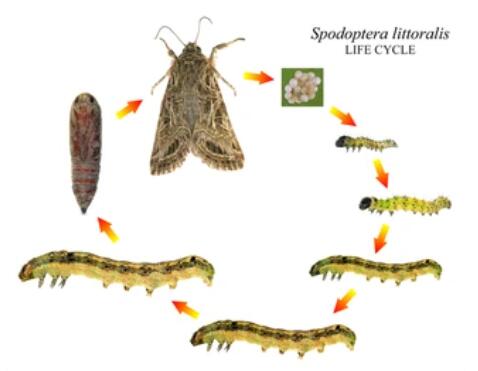Spodoptera littoralis belongs to the family Noctuidae and is widely distributed in Africa, Mediterranean Europe, and Middle Eastern countries. The forewings of Spodoptera littoralis are grayish-brown and have eyelets made up of white diagonal lines. The hindwings are usually lighter in color with gray edges. It is a highly omnivorous organism and a pest of many cultivated plants and crops such as cotton, tomatoes, corn, and other vegetables. Most damage is a direct result of heavy feeding by the larvae.

Olfaction plays an essential role in the life cycle of Spodoptera littoralis, regulating many vital behaviors such as host plant localization, mate choice, oviposition site selection, predator avoidance, and behavioral differentiation. Lifeasible's use of the CRISPR/Cas9 system allows for effective and heritable genetic mutation analysis of the crop pest Spodoptera littoralis.
| Editable genes | Relevant traits exhibited after editing |
| Orco | Odor receptors (ORs) are crucial as odor-gated ion channels in insect olfaction. They are formed by heteromultimeric complexes of odorant receptor co-receptor (Orco) and ligand-selective Or. OR-mediated olfaction is essential for pheromone communication, oviposition selection, and larval chemotaxis in Spodoptera littoralis. Knockdown of the Orco gene allowed the study of its function in olfaction in Spodoptera littoralis. Mutants exhibit loss of olfaction. |
| PBP3 | Obtaining pure Spodoptera littoralis by targeting the pheromone-binding protein 3 (PBP3) gene allows you to study this gene's role in female sex pheromone olfaction better. By co-injecting Cas9 mRNA and sgRNA into Spodoptera littoralis eggs and detecting efficient chimeric mutations in the PBP3 locus. |
Besides, we can also provide you with the editing of olfactory-related genes such as Gr1, Gr2, Gr3, TRPA1, PBP1, PBP2, GOBP1, and GOBP2. It is suitable for transcriptomics, neuroanatomy, electrophysiological recordings, and behavioral test studies to help you clarify the function of critical genes in Spodoptera littoralis.
Lifeasible offers a CRISPR/Cas9-based system for genetic genome editing of Spodoptera littoralis. This allows you to develop strategies to disrupt the mate-searching and host-seeking behaviors of the pest Spodoptera littoralis by repressing or silencing essential genes, thereby suppressing the reproduction of the pest. Please feel free to contact us to develop an editing system for your key genes.